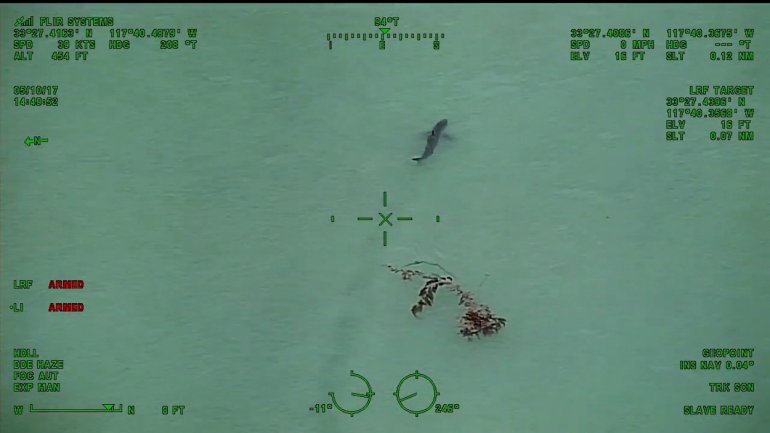
Shark advisory issued after 15 Great Whites spotted near California beach.
California paddleboarders found themselves in what resembled an outtake from ‘Jaws’ when the chilling announcement was made that they were just metres from a school of around 15 great white sharks.
In helicopter footage taken by Orange County Sheriff’s Department, the creatures’ forms, which the aircraft’s occupants observe are 10 feet (3 meters) long, could be seen through the clear water just off the California coastline.
A loudspeaker announcement from the helicopter said that the area was “heavily populated with large great white sharks” and that the creatures had come “as close as the surf line”.
The paddleboarders were then advised to “exit the water in a calm manner”.
2016 had a record number of shark attacks and bites (107) which surpassed the previous record of ninety-eight set in 2015 by nine. However, the total number of fatalities is down from nine worldwide in 2015 to eight in 2016.*
While the number may sound scary, it’s not time to cue the “Jaws” theme song. Record temperatures made the ocean more appealing, while cheaper oil prices made traveling to the beach more affordable.
Again, the 2016 leader for shark bites was the sunshine state of Florida with a total of 34 bites. Thirteen bites happened in the New Smyrna Beach vicinity, a region known as the shark bite capital of the world. The area is a hotbed for surfers, bait fish and sharks.
While it’s a great place for surfers to catch waves, the occasional foot or hand can be caught by a shark. The majority of injuries are non-life threatening and normally range from small bites that need no medical treatment to more serious injuries including torn and severed tendons.
Hawaii had a total of seven shark attack bites and one unconfirmed incident. Five of which occurred off Maui.
2015 saw eight negative shark encounters in North Carolina. Two involved teenagers and both lost arms in shark attacks on the same day. In 2016 only two bites were reported.
California had two incidents involving great white sharks. Maria Korcsmaros was bitten while swimming, but survived and is now training for triathlons. Tyler McQuillen encountered a great white shark while spearfishing. His mementos consisted of a few broken toes and an intense video recording of the incident.
One rare report came from Oregon. In October, 29-year-old trauma nurse Joseph Tanner was bitten by a great white shark while surfing. He was able to make it back to shore and directed his own first aid.
Unfortunately, there were eight fatalities for 2016, three of which were in Australia. Queensland lost Steven “Fozzy” Foster who was diving off Mission Beach in February. Mission Beach also had seven other shark attack bites reported during the year. Western Australia claimed three bites and two fatalities, scuba diver Tim Roberts and surfer Ben Gerring.
Swimmer Nicole Malignon and kite surfer David Jewell were both killed off New Caledonia where three other bites were reported.
Diver Maika Tabua was killed in Fiji in March. Two fishermen also lost their lives—Linaldo Gaudino de Brito off the coast of Brazil, and a man only identified as Julius in Mozambique.
Most shark attacks are simple hit-and-run attacks where the shark makes an investigative bite and then realizes the person is not a food item and leaves the area. However, the size of the investigative shark can mean the difference between life and death.
A large shark can inflict significantly more damage to a human, not only because of its larger jaw size, but also because of the amount of pressure the bite can generate.
Another reason for a larger number of reported shark bites for 2016 is attributed to the speed which humans now communicate. When a shark attack bite occurs, it can be filmed and posted to Facebook or Twitter within seconds. It is a possibility that bites or shark encounters in the past were under-reported.
While 2016 had a record number of shark attacks and bites, sharks are still extremely vital to sustaining healthy oceans and are still being killed at alarming rates. Commercial fishing is one of the bigger threats to sharks. While sharks may not always be targets, they can still be killed when caught unintentionally.
One final issue that should be mentioned is a threat much scarier than any shark bite: the number of swimmers who die by drowning.
According to the Royal Life Saving, 280 people in Australia drowned in Australian waterways, 23% drowned at the beach from July 1, 2015, to June 30, 2016. In Spain, 437 people died from drowning, over 50% were at the beach.
While drowning is a more serious threat when people enter the water, those concerned about sharks may be interested in downloading the shark-reporting app Dorsal.
The Dorsal app is a community-based shark alert tool that features government shark notifications and allows users to post their own sightings.
There are also several wearable shark prevention devices available for sale.













